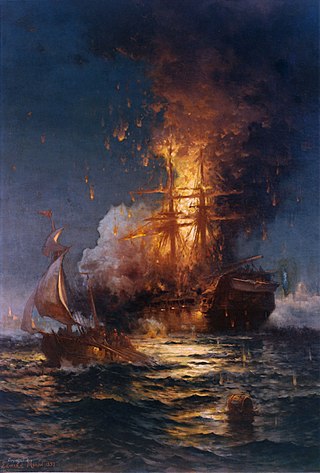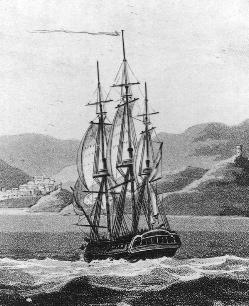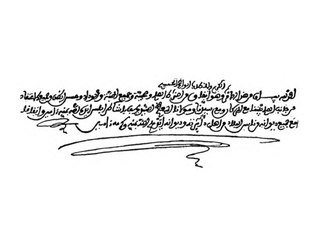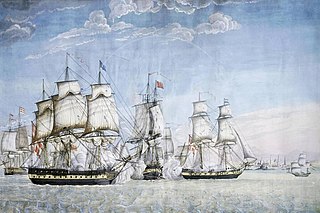
Tripoli is the capital and largest city of Libya, with a population of about 1.183 million people in 2023. It is located in the northwest of Libya on the edge of the desert, on a point of rocky land projecting into the Mediterranean Sea and forming a bay. It includes the port of Tripoli and the country's largest commercial and manufacturing center. It is also the site of the University of Tripoli.

The War of the Spanish Succession was a European great power conflict fought between 1701 and 1714. The immediate cause was the death of the childless Charles II of Spain in November 1700, which led to a struggle for control of the Spanish Empire amongst supporters of the claimant Bourbon and Habsburg dynasties. His official heir was Philip of Anjou, a grandson of Louis XIV of France, whose main backers were France and most of Spain. His rival, Archduke Charles of Austria, was supported by the Grand Alliance, whose primary members included Austria, the Dutch Republic, and Great Britain. Significant related conflicts include the 1700 to 1721 Great Northern War, and Queen Anne's War in North America.
The diplomatic history of the United States oscillated among three positions: isolation from diplomatic entanglements of other nations ; alliances with European and other military partners; and unilateralism, or operating on its own sovereign policy decisions. The US always was large in terms of area, but its population was small, only 4 million in 1790. Population growth was rapid, reaching 7.2 million in 1810, 32 million in 1860, 76 million in 1900, 132 million in 1940, and 316 million in 2013. Economic growth in terms of overall GDP was even faster. However, the nation's military strength was quite limited in peacetime before 1940.

William Bainbridge was a commodore in the United States Navy. During his long career in the young American Navy he served under six presidents beginning with John Adams and is notable for his many victories at sea. He commanded several famous naval ships, including USS Constitution, and saw service in the Barbary Wars and the War of 1812. Bainbridge was also in command of USS Philadelphia when she grounded off the shores of Tripoli, Libya in North Africa, resulting in his capture and imprisonment for many months. In the latter part of his career he became the U.S. Naval Commissioner.

The First Barbary War (1801–1805), also known as the Tripolitan War and the Barbary Coast War, was a conflict during the Barbary Wars, in which the United States and Sweden fought against Tripolitania. Tripolitania had declared war against Sweden and the United States over disputes regarding tributary payments made by both states in exchange for a cessation of Tripolitanian commerce raiding at sea. United States President Thomas Jefferson refused to pay this tribute. Sweden had been at war with the Tripolitans since 1800. The First Barbary War was the first major American war fought outside the New World, and in the Arab world.

The Barbary Wars were a series of two wars fought by the United States, Sweden, and the Kingdom of Sicily against the Barbary states and Morocco of North Africa in the early 19th century. Sweden had been at war with the Tripolitans since 1800 and was joined by the newly independent US. The First Barbary War extended from 10 May 1801 to 10 June 1805, with the Second Barbary War lasting only three days, ending on 19 June 1815. The Barbary Wars were the first major American war fought entirely outside the New World, and in the Arab World.

USS Philadelphia, a 1240-ton, 36-gun frigate, was the second vessel of the United States Navy to be named for the city of Philadelphia. Originally named City of Philadelphia, she was built in 1798–1799 for the United States government by residents of that city. Funding for her construction was raised by a drive that collected $100,000 in one week, in June 1798. She was designed by Josiah Fox and built by Samuel Humphreys, Nathaniel Hutton and John Delavue. Her carved work was done by William Rush of Philadelphia. She was laid down about November 14, 1798, launched on November 28, 1799, and commissioned on April 5, 1800, with Captain Stephen Decatur, Sr. in command. She was captured by Barbary pirates in Tripoli with William Bainbridge in command. Stephen Decatur led a raid that burned her down, preventing her use by the pirates.

The Treaty of Tripoli was signed in 1796. It was the first treaty between the United States and Tripoli to secure commercial shipping rights and protect American ships in the Mediterranean Sea from local Barbary pirates.

The Mediterranean Squadron, also known as the Mediterranean Station, was part of the United States Navy in the 19th century that operated in the Mediterranean Sea. It was formed in response to the First and Second Barbary Wars. Between 1801 and 1818, the squadron was composed of a series of rotating squadrons. Later, squadrons were sent in the 1820s to the 1860s to suppress piracy, primarily in Greece and to engage in gunboat diplomacy. In 1865 the force was renamed the European Squadron.

The Action of 16 May 1797 was a naval battle that took place near Tripoli in Ottoman Tripolitania. The Danish squadron was attacked by a Tripolitan squadron that outnumbered them in number of vessels. The result was a strategic victory for Tripoli.
The Karamanli dynasty was an autonomous dynasty that ruled Ottoman Tripolitania from 1711 to 1835. Their territory comprised Tripoli and its surroundings in present-day Libya. At its peak, the Karamanli dynasty's influence reached Cyrenaica and Fezzan, covering most of Libya. The founder of the dynasty was Ahmed Karamanli, a descendant of the medieval Karamanids. The most well-known Karamanli ruler was Yusuf ibn Ali Karamanli who reigned from 1795 to 1832, who fought a war with the United States between 1801 and 1805. Ali II was the last of the dynasty.
Yusuf Karamanli, Caramanli or Qaramanli or al-Qaramanli, (1766–1838) was the longest-reigning Pasha of the Karamanli dynasty of Tripolitania. He is noted for his role in the Barbary Wars against the United States.

Ottoman Tripolitania, also known as the Regency of Tripoli, was officially ruled by the Ottoman Empire from 1551 to 1912. It corresponded roughly to the northern parts of modern-day Libya in historic Tripolitania and Cyrenaica. It was initially established as an Ottoman province ruled by a pasha (governor) in Tripoli who was appointed from Constantinople, though in practice it was semi-autonomous due to the power of the local Janissaries. From 1711 to 1835, the Karamanli dynasty ruled the province as a de facto hereditary monarchy while remaining under nominal Ottoman suzerainty. In 1835, the Ottomans reestablished direct control over the region until its annexation by Italy in 1912.

Italian Tripolitania was an Italian colony, located in present-day western Libya, that existed from 1911 to 1934. It was part of the territory conquered from the Ottoman Empire after the Italo-Turkish War in 1911. Italian Tripolitania included the western northern half of Libya, with Tripoli as its main city. In 1934, it was unified with Italian Cyrenaica in the colony of Italian Libya. In 1939, Tripolitania was considered a part of the Kingdom of Italy's 4th Shore.

The First Battle of Tripoli Harbor was a naval battle fought on May 16, 1802, in Tripoli Harbor between a combined force consisting of the American frigate USS Boston and two Swedish Navy frigates against several Tripolitan Barbary corsairs. The Swedish-American force was enforcing the blockade when an engagement broke out between it and Tripolitan forces. The Allied fleet damaged the Tripolitan squadron as well as the harbor fortifications before withdrawing and resuming the blockade.

The action of 1 August 1801 was a single-ship action of the First Barbary War fought between the American schooner USS Enterprise and the Tripolitan polacca Tripoli off the coast of modern-day Libya.

The Tripolitanian civil war was a conflict from 1790 to 1795 which occurred in Tripolitania – inside what is today the country of Libya. It involved a war of succession between leading members of the Karamanli dynasty, an intervention by Ottoman officer Ali Burghul who claimed to be acting on the sultan's orders and controlled Tripoli for 17 months, and an intervention by the bey of Tunis Hammuda ibn Ali to restore the Karamanlis to power.

The Battle of Tripoli took place between the navies of the Kingdom of Sardinia and Vilayet of Tripoli on 26 September 1825 during the Sardinian-Tripolitanian war of the same year. In order to resist Tripolitanian demands for increased tribute, the Sardinian king sent a squadron to force Tripoli to a favorable peace treaty. The Tripolitanians refused to change their demands and as a result the Sardinian squadron assaulted the city of Tripoli, sinking several vessels and landing a force to attack the city. Suffering heavy naval losses the Tripolitanian government quickly agreed to a favorable peace treaty with Sardinia, thus ending the war on favorable terms for the Sardinians.
The 1805 Treaty of Tripoli was signed on June 4, 1805, ending the First Barbary War. It was negotiated by Tobias Lear, an ardent Jeffersonian republican, and took effect April 12, 1806 with the signature of President Thomas Jefferson.

The Vandal War (461–468) was a long-term conflict between the two halves of the Roman Empire on the one hand and the Vandals in North Africa on the other. This war revolved around hegemony in the Mediterranean and the empire of the west. The Vandals as a rising power posed an enormous threat to the stability of the Roman Empire. Piracy and plunder were a scourge, threatening trade throughout the Mediterranean. The Roman war effort from 466 onwards was aimed at the destruction of the Vandal Kingdom in order to restore the empire to its original territory. Armed conflicts alternated with peace talks and the two parts of the Roman Empire did not always act in unison.













